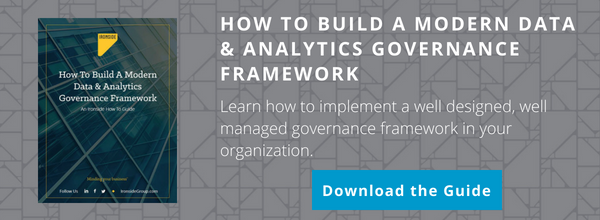How To Start Your MDM Journey on the Right Foot
Any journey requires a few things before getting started. Wandering through the forest can be a very pleasant experience, but if you don’t plan ahead and bring your compass and map, what happens if you get lost? (I know, you probably brought your smart phone, which has GPS. But then you find there is no signal, way out here in the forest…). Before starting an adventure like this, you need to prepare and make sure you are ready for any obstacles or unknowns that could occur.
In business, “wandering around” can be a very costly and unrewarding experience, and planning is one of the most important things you can do. Implementing a mature data governance and master data management program is like hiking the Appalachian Trail. Most trekkers don’t hike directly from one end to the other, but rather break the journey up into several hikes and start with the most satisfying and enjoyable segment based on their interests. They plan each hike in detail but have a course plotted for the entirety. You will want to break up your MDM journey into segments based on value to the company.
There are a few steps you need to take when getting started on your journey:
Step 1: Assemble your Steering Committee (your trekking party)
Steering Committee members have a clear understanding of how their business unit works, the goals of the company, and the deficiencies or “pain points” that data can impose on their objectives. These members are usually business unit heads or delegates experienced with the operations of their unit.

First, add a “Champion” to your trekking party to be the sponsor of your MDM journey. This person will be your advocated and evangelist when seeking funding and building momentum within the executive team at your company.
You will also want to add a Navigator to the team. The MDM journey often has many new concepts and activities that a company will encounter. Find a person with experience in planning and delivering MDM programs to help guide you. The right person will save countless hours of discussion and false paths along the way.
As you assemble your team, you can get back to work on defining what your MDM strategy will be.
Step 2: Decide where you want to go
What are your current pain points? It is important to catalog and prioritize the places where data is causing additional cost, customer satisfaction issues, reporting inaccuracies and missed opportunities. I recommend developing a formal collection process within your data governance group that lives beyond the MDM implementation.
Develop an Enterprise Glossary
As companies grow and evolve, the language of the company can become siloed and separated. Different vendor solutions, mergers and acquisitions, and autonomous business units develop their own terminology for data. Throw in a slew of acronyms and folklore and all of a sudden people are speaking different dialects of the same thing.
(It’s hard to set a course for Crystal Lake when half of your party calls it a pond).
To be able to collect, merge and view this data together, a common glossary of terms and definitions will be needed. When complete, share this glossary across the enterprise and build it into employee onboarding to build a culture of common understanding.
Opportunities or a better journey
On the Appalachian Trail, everyone may want to get to Mount Katahdin as their destination, but you may want to consider attending the “flip flop festival” in Harpers Ferry, VA to really enhance your experience. Most people think of MDM as data cleansing and golden record, but there can be tremendous opportunity as well.
Build in cross-sell and upsell capabilities and add geocoding to know where your customers are, how much they make, and the demographic categories they are surrounded by. Maybe you want your customers to maintain their own information through an online portal or streamline your onboarding process through integration.
Putting your thoughts on paper
Once you have the pain points and opportunities outlined, you will want to build out your use cases. This is where you will define what you want and what you will need on each leg of the journey. Say you want to get a great family photo at McAfee Knob in Roanoke, VA to use in your next Christmas card. You’ll need that red flannel shirt, your camera and haircuts for the kids.
For an MDM use case, you will want to identify the desired outcomes of your effort, such as a consolidated view of your customer data, which comes from multiple ERP and CRM systems. For this you will need the name, address, phone number and email address of each customer for each source system, as well as the glossary and the concept of how you want to use your data once cleansed, merged and stored.
You can then consolidate and prioritize the list of use cases. Those use cases – which have a good deal of overlap – may be consolidated to get more from each segment. Prioritizing the list based on impact and business value will allow you to order your work into a roadmap, providing the most reward first.
Step 3: Equip yourself for the journey
Now that you know where you want to go and where you want to start, it’s time to decide on the equipment you need to make the journey happen.
When selecting a pair of hiking boots, you may ask yourself, are they waterproof and rugged? Are they heavy or light and nimble? Do I care about name brands? How much do they cost? Do I need multiple pairs depending on the terrain and weather?
Start working with your IT counterparts and your Navigator to help determine the best solutions for the overall MDM program. With their help, you will be able to assess the requirements your MDM platform will need in order to achieve your list of use cases.
Invite MDM vendors in for show-and-tells and discussions about how they can fill your requirements. Often vendors are very happy to do small Proof of Concepts (POC) to show how your use cases will operate using their product.
Here are some common features to consider when selecting your MDM platform:

Step 4: Honing your technique
You may have put that compass in your backpack, but can you navigate with it? You now have a really great looking tent but where do all these sticks go? Becoming familiar with your master data management platform is essential to the success of your first and subsequent projects on the MDM journey.
Understanding best practices and learning the techniques of MDM should be practiced before you head out. Although the demos might make sense and look easy, it’s rare that sophisticated tools work out of the box without practice. As you would set that new tent up in the backyard to practice for your hike, a POC, good design sessions and familiarization with how things fit together will help avoid the discomfort of learning on the trail.
Time to get trekking
With the team defined and your roadmap and equipment in hand, you can start on your first leg of the journey. Most find the first hike the most arduous, but once behind you, your steps quicken, the equipment feels lighter and the rewards will start to be realized. You may be way out in the forest, but you’ll be well equipped and know where you’re going. Happy trails!
About Ironside
Ironside was founded in 1999 as an enterprise data and analytics solution provider and system integrator. Our clients hire us to acquire, enrich and measure their data so they can make smarter, better decisions about their business. No matter your industry or specific business challenges, Ironside has the experience, perspective and agility to help transform your analytic environment.






